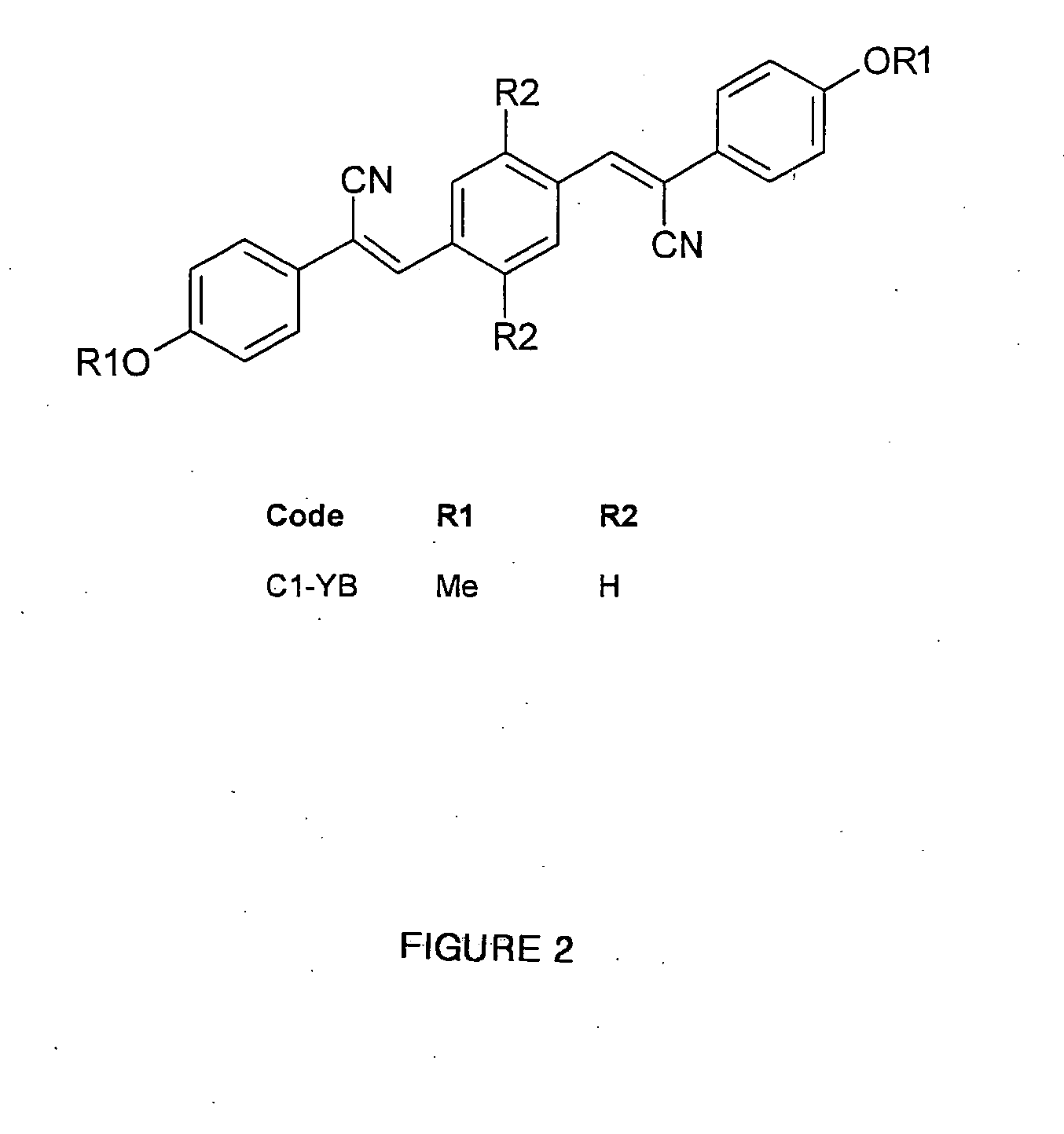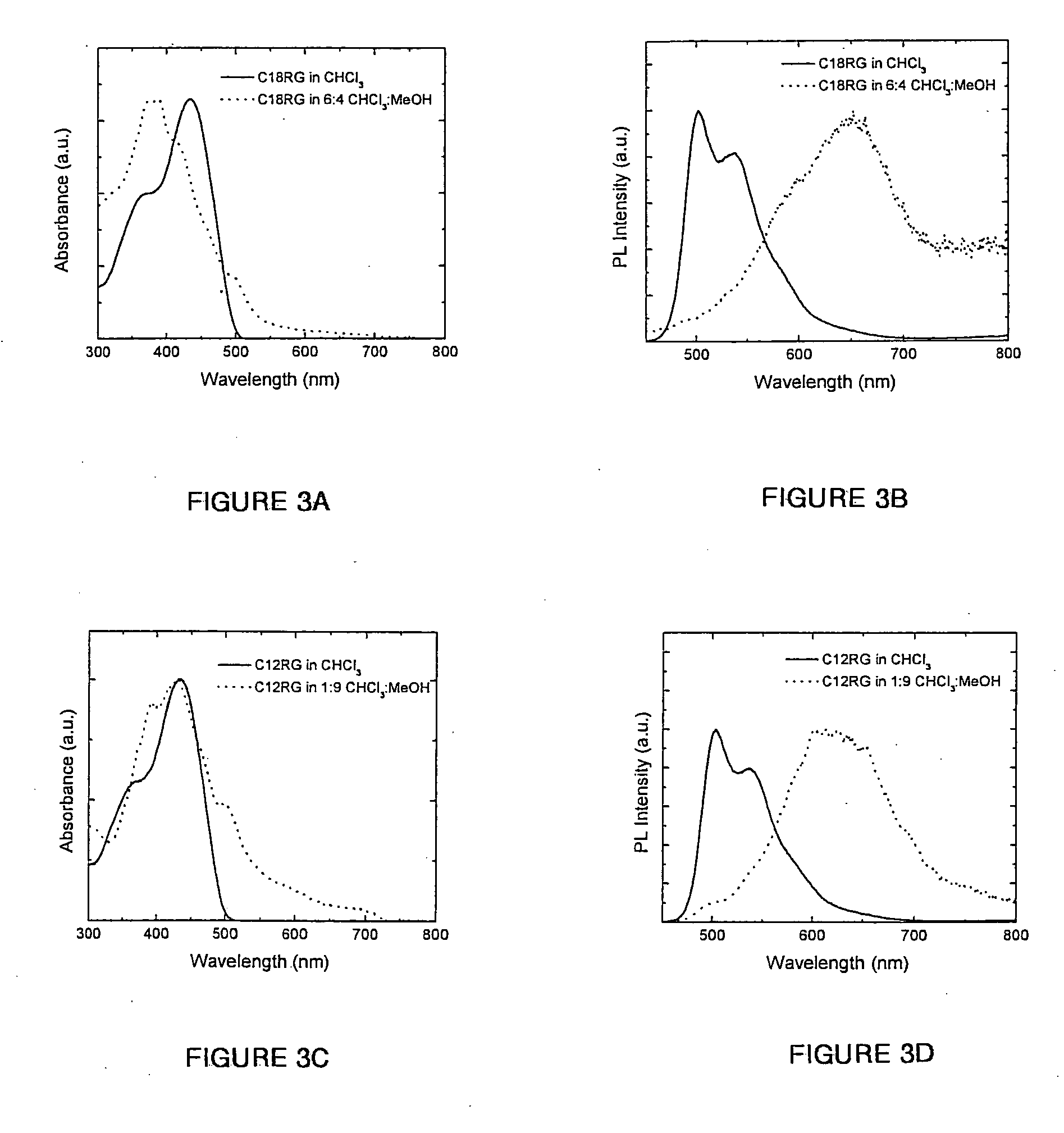Time-temperature indicators
a technology of indicators and time-temperature, applied in the field of time-temperature indicators, can solve the problems of not providing, presently available tti materials, devices and systems suffering severe limitations, and even fewer prototypes, and achieve the effects of easy measurement, easy reading and understanding, and low cost of manufactur
- Summary
- Abstract
- Description
- Claims
- Application Information
AI Technical Summary
Benefits of technology
Problems solved by technology
Method used
Image
Examples
example b
[0080] Aggregachromic dye C1-RG (FIG. 1A) was synthesized according to literature procedures (Lowe, C.; Weder, C. Synthesis 2002, 9, 1185). Aggregachromic dyes C18-RG, C12-RG, C1-RG, and C2-RY8 (FIGS. 1A and 1B) were synthesized as follows: Synthesis of (4-dodecyloxyphenyl)acetonitrile. A suspension of K2CO3 (4.05 g, 29.2 mmol) in dimethylformamide (15 mL) was purged with Ar for 15 minutes, heated to 80° C., and 4-hydroxyphenylacetonitrile (1.47 g, 11.0 mmol) was added. After stirring at 80° C. for 10 minutes, 1-bromododecane (3.54 g, 14.2 mmol) was slowly added and the suspension was stirred at 80° C. under Ar for another 4 hours. After this time a pale yellow precipitate had formed. The reaction was terminated by pouring the suspension into ice-water (150 mL) and CHCl3 (50 mL) was added to dissolve the precipitate. The organic layer was separated off and the aqueous phase was extracted with CHCl3 (3×50 mL). The combined organic layers were washed with H2O and saturated aqueous NaC...
example 1
According to Invention
[0087] Materials and articles comprising between 0.2 and 5% of one of the aggregachromic dyes C18-RG, C12-RG, C2-RY8 or between 2 and 5% C1-RG and one of the polymers of poly(methyl methacrylate) (PMMA), poly(butyl / methyl methacrylate) copolymers, poly(ethylene terephthalate) (PET), and poly(ethylene terephthalate glycol) (PETG) were prepared by feeding the appropriate amounts of dye and the polymer into a recycling, co-rotating twin-screw mini-extruder (DACA Instruments, Santa Barbara, Calif.), mixing for 3-5 minutes at about 200-220° C. (PMMA, poly(butyl / methyl methacrylate) copolymers), 230-250° C. (PETG) and 280° C. (PET, PETG), and subsequent extrusion. Films were prepared by compression-molding the blends at the same temperature at which they were extruded between two aluminum foils that were optionally covered with covered with Kapton films in a Carver press using spacers for approximately 1-3 minutes. The films were immediately quenched after removal f...
example 2
According to Invention
[0094] Materials and articles comprising between 0.2 and 4% of one of the aggregachromic dyes C18-RG and C12-RG and one of the polymers of poly(methyl methacrylate) (PMMA), poly(butyl / methyl methacrylate) copolymers, poly(ethylene terephthalate) (PET), and poly(ethylene terephthalate glycol) (PETG) were prepared by feeding the appropriate amounts of dye and the polymer into a recycling, co-rotating twin-screw mini-extruder (DACA Instruments, Santa Barbara, CA), mixing for 3-5 minutes at about 200-220° C. (PMMA, poly(butyl / methyl methacrylate) copolymers), 230-250° C. (PETG) and 280° C. (PET, PETG), and subsequent extrusion. Films were prepared by compression-molding the blends at the same temperature at which they were extruded between two aluminum foils that were optionally covered with covered with Kapton films in a Carver press using spacers for approximately 1-3 minutes. The films were immediately quenched after removal from the hot press by immersion in a...
PUM
| Property | Measurement | Unit |
|---|---|---|
| Fraction | aaaaa | aaaaa |
| Fraction | aaaaa | aaaaa |
| Fraction | aaaaa | aaaaa |
Abstract
Description
Claims
Application Information
 Login to View More
Login to View More - R&D
- Intellectual Property
- Life Sciences
- Materials
- Tech Scout
- Unparalleled Data Quality
- Higher Quality Content
- 60% Fewer Hallucinations
Browse by: Latest US Patents, China's latest patents, Technical Efficacy Thesaurus, Application Domain, Technology Topic, Popular Technical Reports.
© 2025 PatSnap. All rights reserved.Legal|Privacy policy|Modern Slavery Act Transparency Statement|Sitemap|About US| Contact US: help@patsnap.com



